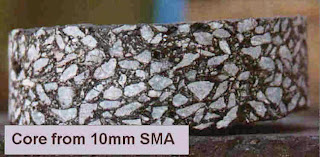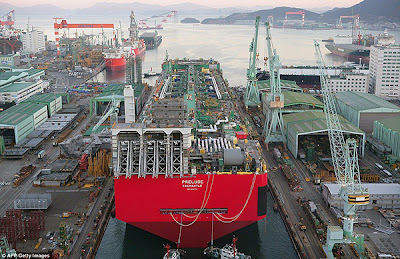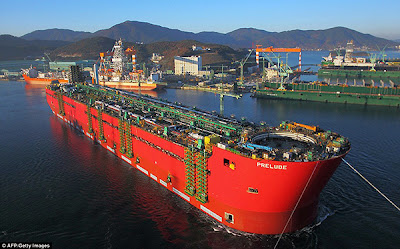There are three major types of asphalt
surfacing, characterized by a mixture of bitumen and stone aggregate. These
are: Dense Graded asphalt (DGA); Stone Mastic Asphalt (SMA) and Open Graded
Asphalt (OGA). Asphalt surfacing differs by the proportion of different size
aggregate, the amount of bitumen added and the presence of other additives and
material.
 |
Stone mastic asphalt (SMA), also called stone-matrix asphalt, was developed in
Germany in the 1960s. It provides a deformation resistant, durable surfacing
material, suitable for heavily trafficked roads. SMA has found use in Europe,
Australia, the United States, and Canada as a durable asphalt surfacing
option for residential streets and highways. SMA has a high coarse aggregate content
that interlocks to form a stone skeleton that resists permanent deformation.
The stone skeleton is filled with mastic of bitumen and filler to
which fibers are added to provide adequate stability of bitumen and
to prevent drainage of binder during transport and placement. Typical SMA
composition consists of 70−80% coarse aggregate, 8−12% filler, 6.0−7.0% binder,
and 0.3 per cent fiber.
Difference Between SMA
& Conventional Mixes:
 |
| Stone Mastic Asphalt Composition |
The second difference lies in the binder content,
which lies between 5-6 percent for conventional mixes. Below this the mix
becomes highly unstable. Above this percent will lead to abrupt drop of
stability because the binder fills all the available voids and the extra binder
makes the aggregates to float in binder matrix. The SMA uses very high percent
of binder > 6.5 percent which is attributed to filling of more amount of
voids present in it, due to high coarse aggregate skeleton. The high bitumen
content contributes to the longevity of the pavements.
The third difference is the use of stabilizing
additives in SMA, which is attributed to the filling up of large number of
voids in SMA so as to reduce the drain down due to presence of high bitumen
content. On the contrary, there is no stabilizing agent in conventional mixes
since the bitumen content is moderate, which only serves the purpose of filling
the moderate amount of voids and binding the aggregates
Composition of SMA:
1. Asphalt (Binder)
2. Aggregate
3. Fibers
4. Mineral filler
Advantages:
• High stability against permanent deformation (rutting) and high wear resistance.
• Slow aging and durability to premature cracking of the asphalt
• Longer service-life
• SMA has a higher macro-texture than dense-graded pavements for better friction
• Reduced spray, reduced hydroplaning and reduced noise.
• Good low temperature performance
• Even though SMA has a higher cost than conventional dense mixes, approximately 20 to 25 percent, the advantages of longer life (decreased rutting and increased durability).
Disadvantages:
• Increased cost associated with higher binder and filler contents, and fiber Additive,
• High filler content in SMA may result in reduced productivity. This may Be overcome by suitable plant modifications,
• Possible delays in opening to traffic as SMA mix should be cooled to 40 oC to prevent flushing of the binder surface, and
• Initial skid resistance may be low until the thick binder film is worn off the top of the surface by traffic.








